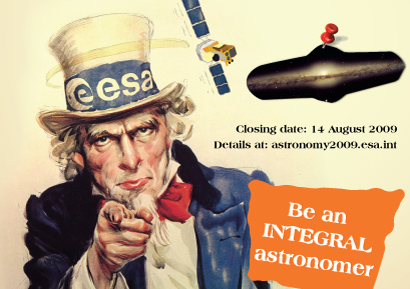Be an INTEGRAL astronomer - competition
 |
Competition for secondary students and University undergraduatesDeadline: 14 August 2009 |
The Competition
By participating in this competition you too can explore the fascinating Galactic Bulge. Join the community of astronomers who are studying the violent and exotic processes that define this region of our Galaxy.
Be an INTEGRAL astronomer! Perform the mission and report back to us before 14 August, and be in with a chance to win some great prizes. Click the link below for your mission.
|
In their professional lives astronomers study, classify and describe the nature of the Universe. Until the late 19th century the Universe could be viewed only in visible light. The rapid development in technology in the 20th century resulted in the construction of innovative instrumentation which began to reveal the Universe through regions of the spectrum that had previously been hidden. The advent of the space age removed the final barrier to a complete view of the heavens.
Nowadays there are so many ways to study the Universe that most astronomers specialize in one domain of astronomy. They restrict their studies to one part of the spectrum and collaborate with other colleagues in order to build a complete picture of the multi-wavelength Universe.
INTEGRAL space observatory
 |
The rich central hub of our Galaxy
Since 2005 astronomers have been regularly monitoring the central hub of our Galaxy known as the Galactic Bulge. This is one of the oldest regions of our Galaxy and is a region rich in bright, variable high-energy X-ray and gamma-ray sources. Some of the most extreme objects in our Galaxy can be found there. These sources are so variable that the region never looks exactly the same. Astronomers would like to understand why these objects vary so much. Observing this region with INTEGRAL is a very efficient way to monitor this region because the entire Galactic Bulge can be viewed at one time. The data obtained during these monitoring observations is of such importance to the astronomical community that it is immediately made publicly available.
